
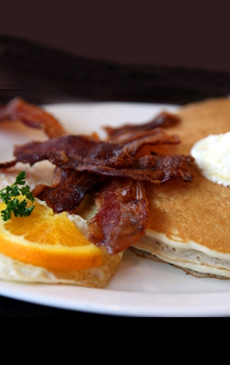 Bacon: One of America’s favorite foods, it’s enjoyed for breakfast, lunch, and dinner. American-style bacon is called streaky bacon (photo © Niman Ranch). Bacon: One of America’s favorite foods, it’s enjoyed for breakfast, lunch, and dinner. American-style bacon is called streaky bacon (photo © Niman Ranch).
October 2012
Last Updated August 2025
|
 |
Types Of Bacon: A Glossary Of The Different Bacon Types
Page 1: Terms From A To L
Different types of bacon are cut from different parts of the pig. While they have in common the salting and curing of the meat, the appearances, textures, and flavors vary. Bacon can be cut into strips or rolled (to be cut during preparation). Also see our Pork Glossary, Beef Glossary, and Lamb Glossary. We have a food glossary for almost every category of food.
International Bacon Day is celebrated on August 31st: a great opportunity to try bacon styles from different countries.
This glossary is protected by copyright and cannot be reproduced in whole or in part. You are welcome to link to it.
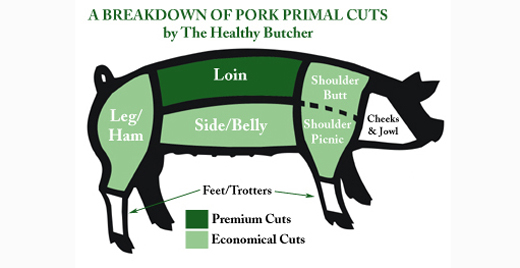
AMERICAN BACON
See streaky bacon.
APPLEWOOD BACON
Since the beginning of bacon (see the history of bacon), the meat was smoked over whatever local wood was available. With the advent of national trade shows, people noticed that bacon smoked over mesquite, for example, tasted different from bacon smoked over apple, hickory, and other woods. The flavors imparted by apple wood (as well as hickory) are very complementary to bacon, and “applewood smoked” has come to have more consumer appeal than generic smoked bacon.
BACK BACON, CANADIAN BACON, or IRISH BACON
Back bacon is usually cut thicker than American “streaky” bacon. This cut comes from the loin of the pig, which is located in the middle of its back; hence the term back bacon. The fat can be easily trimmed, making back bacon a very lean, meaty cut of bacon with a ham-like texture. However, Irish bacon maintains a layer of fat around the meat to enhance the flavor.
|
|
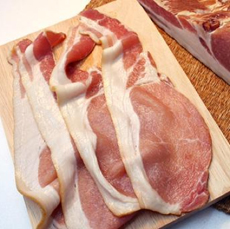
Back bacon. Photo courtesy OnlyWithTilia.com. |
BACON
A cut of pork that is salted, then cured. The result, fresh bacon (also known as green bacon), may further be air-dried, boiled, or smoked. There are many variations to please the consumer: sliced thick or thin, center-cut, precooked, microwaveable, and made from beef, salmon, turkey, and other proteins. It can be further flavored with different wood smokes: applewood and hickory, for example. In the U.S., more than 70% of bacon is consumed at breakfast, although bacon is also very popular on hamburgers and sandwiches. The difference between bacon, ham, and salt pork is in the brining. Bacon brines have added curing ingredients, and ham brines often include a large amount of sugar. Sodium polyphosphate can be added to bacon to improve sliceability and reduce spattering in the pan.
BACON JERKY
Bacon jerky is made from smoked, dry-cured bacon. As with other jerky, a slow heating process removes the moisture from the meat, to provide a long shelf life with no refrigeration required.
|
|
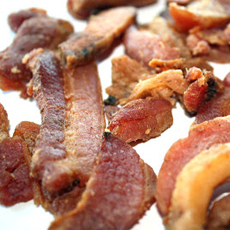
Back bacon. Photo courtesy Wild Bill’s Bacon Jerky. |
BEEF BACON
Beef bacon is a product made from a steer’s belly meat, close to the flank area. It is smoked and flavored with spices to taste like bacon. It is generally made by producers of healthier, grass-fed beef, who create a “leaner, healthier bacon” (beef bacon is up to 90% leaner than pork bacon). Beef bacon also contains the Omega-3s and CLA of grass-fed beef. It can be found at health food stores, special-ordered from butchers, and ordered online from producers such as GrasslandBeef.com.
BROWN SUGAR OR CANDIED BACON
See maple-cured bacon.
|
|
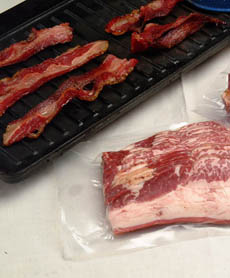
Beef bacon. Photo courtesy GrasslandBeef.com. |
CANADIAN BACON
Canadian bacon, known as back bacon in Canada, is cut from the loin without including the surrounding fat, as English bacon does. It is thus very lean and lightly smoked and cut from the loin. See back bacon.
COLLAR BACON
Bacon that’s made from meat cut from the back of the pig, near the head.
COTTAGE BACON
A meaty, lean meat from the pig’s shoulder that is cured and cut into thin, oval slices for baking or frying. It is a meatier bacon, often smoked with a hickory flavor.
COUNTRY BACON
Popular in the South, this style is typically heavily smoked, saltier, and thickly sliced.
|
|
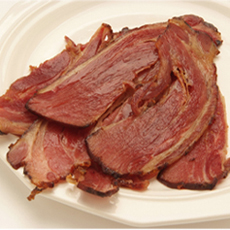
Cottage bacon. Photo courtesy ExurbanPedestrian.Wordpress.com.
|
CURED BACON
Most supermarket bacon is cured, using preservatives such as sodium nitrite. In the 18th century, the British system for making bacon became widespread in Europe. For centuries, bacon was cured with saltpeter, a teaspoon for 100 pounds of meat, plus lots of salt. The salt was for flavor; saltpeter was the cure. However, in the late 20th century, saltpeter was banned. with the discovery of harmful nitrates that developed in the curing process.
DRY CURED BACON
Dry cure is an old-style method that uses salt, sugar, and smoke as the preservatives, and not nitrates. As a result, and because the bacon loses water in the dry curing process, it is much more concentrated and intensely flavored—saltier, smokier, and more “bacon-y.” It also doesn’t spatter and curl as much when cooked. The wet cure used commercially often has brine added to it to make it heavier.
ENGLISH BACON
English bacon is cut from the loin, running along the back of the pig, as are Canadian bacon and Irish bacon. It includes a small portion of the pork belly, so it has both lean meat and a bit of fat streaking. It looks like a cross between American bacon (streaky belly bacon) and Canadian bacon (lean loin). English bacon is often smoked or cured, as is Canadian bacon, but English bacon is smoked/cured to a greater extent.
GAMMON
Bacon that’s cut from the hind leg of the pig. Also called Wiltshire-cured bacon.
|
|

English bacon (photo © Reddit | Food Porn).
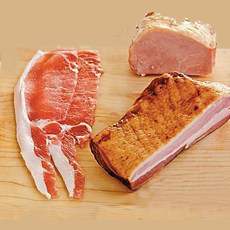
Clockwise from top: Canadian bacon, slab bacon, and English bacon. Photo courtesy Boston.com.
|
GUANCIALE or JOWL BACON
Italian bacon that’s made from the cheeks (jowls, or guancia, pronounced gwon-CHA-lay) of the pig. The jowl is rubbed with salt, sugar, and spices and cured for three weeks. Its flavor is stronger than other pork products, such as pancetta, and its texture is more delicate. Smoked and then sliced or rolled, guanciale is traditionally used in dishes like pasta all’amatriciana and spaghetti alla carbonara. It is a delicacy of central Italy, particularly Umbria and Lazio. Pancetta can be substituted in recipes. In the U.S., it is sometimes called American jowl bacon.
HICKORY SMOKED BACON
Bacon smoked over hickory chips or otherwise infused with hickory flavor.
|
|
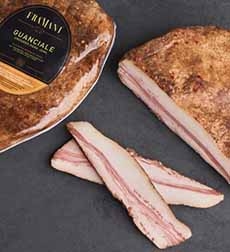
Pancetta. Guanciale is from the jowl of the cheek of the pig, whereas pancetta is from the belly. Photo © Fra Mani.
|
HOCK
Bacon is also made from joint meat. The hock is the ankle joint of the pig, found between the ham and the foot
HUNGARIAN BACON
See szalonna.
IRISH BACON
Irish bacon is similar to English bacon with some differences. Both are cut from the loin of the pig, but Irish bacon usually has more loin and less belly attached than English bacon. It thus tends to be leaner and more ham-like in flavor, more closely resembling Canadian bacon, though usually thicker cut. It’s traditionally wet-cured (brined), giving it a mild, slightly salty flavor. And it’s often unsmoked, so the flavor is more delicate than English smoked varieties.
JOWL BACON
See guanciale, above.
|
|

Irish bacon (photo © Donnelly Meats).
|
LOIN
The pork loin on a pig is located along the upper-middle portion of the pig's back, extending from the shoulder to the rear, between the back fat and the ribs. It's a long, rectangular cut that runs along the spine. See the chart at the top of the page.
The loin is a lean and tender cut of pork. Common cuts from the loin include pork chops, tenderloin, and the trio of British bacons, Canadian, English, and Irish.
|
|

A Berkshire pork tenderloin (photo © Wild Fork Foods).
|
Continue To Page 2, Terms M To Z

|














